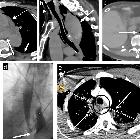traumatische Ösophagusruptur

Infant with
hematemesis who had an unsuccessful nasogastric tube placementCXR AP shows air outlining the heart in the pericardial space, air outlining the thymus in the mediastinum, and air in the bilateral pleural spaces.The diagnosis was pneumopericardium, pneumomediastinum, and pneumothorax due to esophageal perforation from traumatic nasogastric tube placement. A subsequent esophagram did not demonstrate a leak.

Esophageal
emergencies: another important cause of acute chest pain. Esophageal perforation. a, b Iatrogenic esophageal perforation. Eighty-year-old woman with chest pain after transesophageal echocardiography. Axial (a) and sagittal (b) CT images show a dilated and blood-filled upper esophagus (asterisk) contiguous with a large posterior hematoma containing multiple locules of gas (long arrow). Extensive hemo-pneumomediastinum (dashed arrow), small bilateral pleural effusions (short arrow), and subcutaneous emphysema in the lower neck (arrowhead) are seen. c, d Boerhaave syndrome. Eighty-seven-year-old woman with epigastric and back pain after forceful vomiting. c Axial CT image at the gastroesophageal junction shows extraluminal gas surrounding the lower esophagus (arrow). Bilateral pleural effusions (asterisk). d Single contrast esophagography demonstrates luminal narrowing and irregularity of lower esophagus (arrow) with large contrast extravasation into the left pleural space (asterisk). e Traumatic esophageal perforation. Twenty-five-year-old male with gunshot wound to the chest. Axial CT image shows a bullet tract from right axilla to the left upper hemithorax (dashed arrow) resulting in bilateral pneumothoraces (not shown), left hemothorax (asterisk), and pulmonary contusion and laceration in the bilateral upper lobes (arrow). There is esophageal thickening and indistinctiveness with a small hematoma (circle) representing esophageal injury/perforation
traumatische Ösophagusruptur
Siehe auch:

 Assoziationen und Differentialdiagnosen zu traumatische Ösophagusruptur:
Assoziationen und Differentialdiagnosen zu traumatische Ösophagusruptur:

